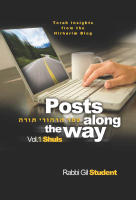
To my delight, it seems that we are slightly ahead of schedule for the publication of my new book,
Posts Along the Way. It looks like pre-orders will begin shipping mid-next week. If you have not already done so, please consider taking advantage of the 20% pre-publication discount (only $17.60):
link.
Don't forget that the Manhattan Book Launch will be on Monday August 10th from 1-2pm at
Levine Judaica. The address is 5 West 30th Street New York, NY 10001. Mincha at 1:40pm.
The book's webpage is here (
link) and includes a full table of contents as well as two blurbs and
three excerpts. The book combines classic essays from this blog about prayers, rabbis and shuls with extensive new material from other places, all updated for new publications and feedback from readers and commenters. Learn about the halachah and hashkafah of shuls in the quick and enlightening blog style. Take a guided tour of the sources and see how they are relevant to the Judaism you live and experience.
 I don't always have the chance to review each book, so I'll list the books that I receive. Some of them will be quoted or reviewed in future posts. Here are the books I've received recently:
I don't always have the chance to review each book, so I'll list the books that I receive. Some of them will be quoted or reviewed in future posts. Here are the books I've received recently: 8:10 AM
8:10 AM
 Gil Student
Gil Student







 Live, Online Tisha B'Av Shiurim at WebYeshiva
Live, Online Tisha B'Av Shiurim at WebYeshiva button in the top right corner of Hirhurim. See
button in the top right corner of Hirhurim. See 





